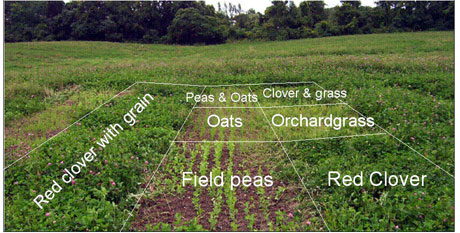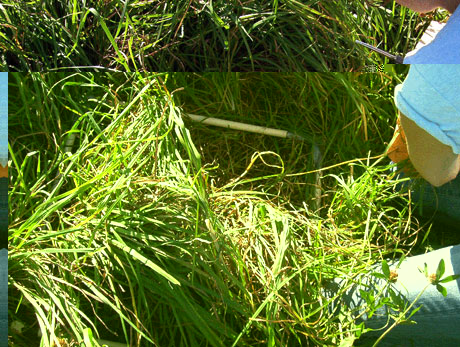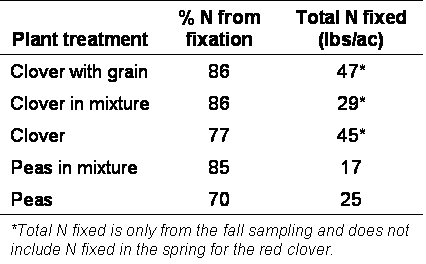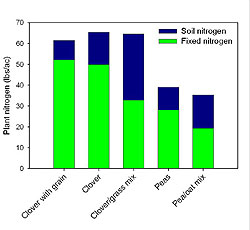Researching legume nitrogen fixation module
How much N do different legumes fix when grown in pure stands and in mixtures with grasses?
How much N do different legumes fix when grown in pure stands and in mixtures with grasses?
As discussed in the legume N fixation learning module, legumes vary in their N fixation due to differences in growth patterns and sensitivity to environmental factors, such as soil N. This experiment compares the N fixation potential of an annual and perennial legume across a range of farm fields. In addition, this experiment compares the N fixation of these legumes grown in a pure stand or in a mixture with grasses.
Research questions:
- How much N do annual and perennial legumes fix? Do they respond similarly to differences in soil fertility?
- In high fertility fields, will legumes fix more N when grown in a mixture with a grass?
The experiment:
Nitrogen fixation was measured in replicated plots on 17 winter grain fields in the Finger Lakes region of New York. The fields ranged in management history from 0 to 20 years under organic management. The legumes used in the study included perennial red clover and annual field pea. The different plots are pictured below (Figure 1).

Larger image
Figure 1. One of 17 on-farm plots after grain harvest in August. Each plot consists of 4 replicate plots of 7 plant treatments: 1) perennial red clover; 2) perennial orchardgrass; 3) red clover/orchardgrass mixture; 4) annual field pea; 5) annual oats; 6) pea/oat mixture; and 7) red clover interseeded with a winter grain.
Clover and orchardgrass were frost-seeded in the spring. Oats and peas were seeded in August after winter grain harvest. Grain stubble was tilled and peas and oats were seeded using a small grain drill. Plant biomass was sampled in October, prior to a killing frost. For the red clover and orchardgrass plots, plant biomass was sampled again the following April, prior to spring tillage.
See: How do we measure N fixation?

Larger image
Figure 2. Fall sampling of orchardgrass plots. All biomass was cut within a 0.5 x 0.5 m frame. Biomass is then dried, weighed, ground and analyzed for N content.
Soils were sampled in each plot. What soil measurements do we use?
Nitrogen fixation results were then compared with the soil test results to see if any of the measures of soil N availability help explain the variability in N fixation for the different legumes grown in mixtures or monocultures.
Preliminary results:
- Perennial red clover and the annual field pea derived similar percentage of N from fixation. Red clover fixed significantly more total N than the pea due to its longer growing period (Table 1, Figure 4).
- The percentage of N in the legume that was from fixation was higher in the mixtures than in the monocultures. The clover interseeded with a winter grain had the same percentage of N from fixation as the clover grown in mixture with orchardgrass (Table 1, Figure 4). This suggests that the winter grain draws down the pool of available soil N before it is harvested similar to a grass growing alongside the red clover in a mixture.
Table 1. Percentage of legume N from fixation and total amount of N fixed for the different legume plots.


Larger image
Figure 4. Total N from soil and from fixation for each plant treatment. Total N uptake was similar for the red clover plots. Total N uptake was lower in the field pea plots than the red clover plots due to the shorter growing period. New N added to each plot through fixation was highest for the clover interseeded with a winter grain and red clover grown in monoculture.
These results are only from the fall sampling. We are still analyzing data from the spring sampling. Data are still being analyzed to look at whether soil fertility explains the variability in N fixation rates across the different fields.
Thought question:
Red clover can be used as a green manure to provide N for a heavy-feeding crop like corn. In the northeast, it is typically frost-seeded into a winter grain crop in the spring. After grain harvest, the clover accumulates biomass quickly through the fall and then again in the following spring before being tilled in. What happens to the N in red clover over the winter? What happens to the red clover N if it is tilled in the fall instead of the spring? Take a moment to think about this and then see our comments.
Back to the Researching legume nitrogen fixation module homepage
© Copyright, Department of Horticulture, Cornell University.
Logo graphics by Rachel Kennedy.
Design by Craig Cramer.
Mention of trade names and commercial products is for educational purposes; no discrimination is intended and no endorsement by Cornell Cooperative Extension or Cornell University is implied. Pesticide recommendations are for informational purposes only and manufacturers' recommendations change. Read the manufacturers' instructions carefully before use. Cornell Cooperative Extension and Cornell University assumes no responsibility for the use of any pesticide or chemicals. Some of the links provided are not maintained by Cornell Cooperative Extension and Cornell University. Cornell Cooperative Extension and Cornell University are not responsible for information on these websites. They are included for information purposes only and no endorsement by Cornell Cooperative Extension or Cornell University is implied. Cornell Cooperative Extension provides equal program and employment opportunities.